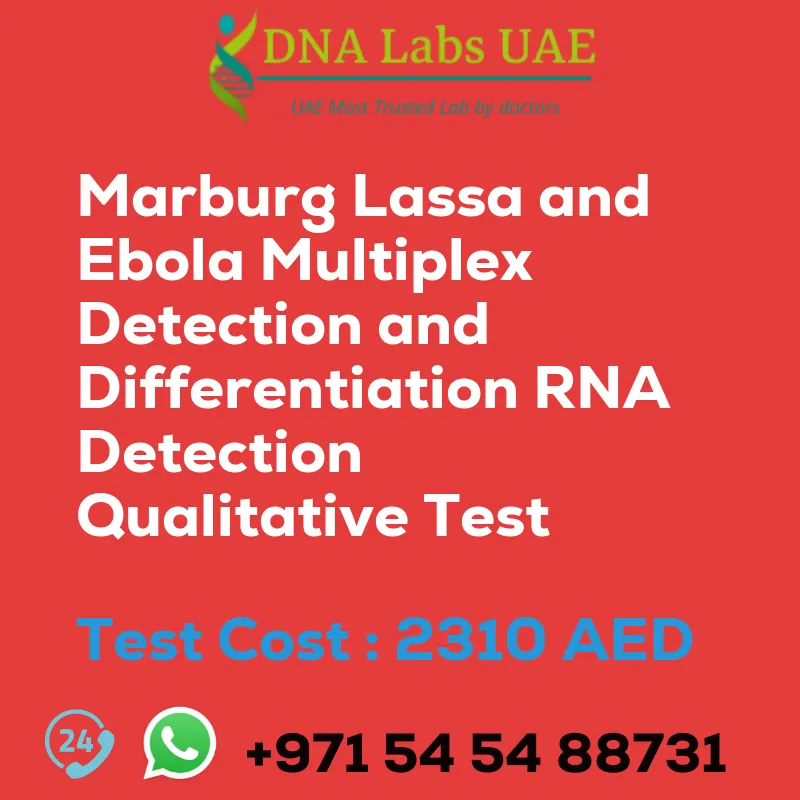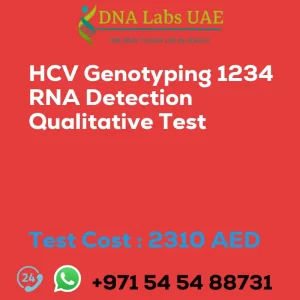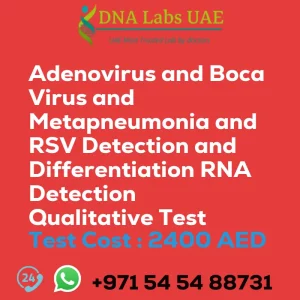Marburg Lassa and Ebola Multiplex Detection and Differentiation RNA Detection Qualitative Test
At DNA Labs UAE, we offer the Marburg Lassa and Ebola multiplex detection and differentiation RNA Detection Qualitative Test at a cost of AED 2310.0. This test is designed to identify and differentiate between the Marburg virus, Lassa virus, and Ebola virus by detecting viral RNA.
Test Components
- Price: 2310.0 AED
- Sample Condition: Whole Blood, serum, plasma, C.S.F.Oral fluid, Oral swab,nasal swabs, throat swabs. Body secretions, organs or other bodily fluids, semen, tears, etc.
- Report Delivery: 4th Working Day (Email: 48 hours, On phone: 36 hours)
- Method: Real Time PCR
- Test Type: Viral
- Doctor: Physician
- Test Department: Genetics
- Pre Test Information: Need to sign Consent document and bring any clinical history of patient for Marburg, Lassa & Ebola multiplex detection and differentiation (RNA Detection) Qualitative Test
Test Details
The Marburg, Lassa, and Ebola multiplex detection and differentiation qualitative test is a diagnostic tool used to identify and differentiate between the Marburg virus, Lassa virus, and Ebola virus. It is based on the detection of viral RNA.
This test utilizes a multiplex polymerase chain reaction (PCR) technique, which allows for the simultaneous amplification and detection of specific regions of the viral genomes. The test targets unique genetic sequences in each virus, enabling the differentiation between them.
The process begins by collecting a sample from the patient, such as blood or tissue. The viral RNA is then extracted from the sample using specialized laboratory techniques. The extracted RNA is then converted into complementary DNA (cDNA) using reverse transcription.
The cDNA is then amplified using specific primers designed to target the unique genetic sequences of the Marburg, Lassa, and Ebola viruses. This amplification step increases the amount of viral genetic material present in the sample, making it easier to detect.
The amplified DNA is then subjected to a detection step, which can be done using various methods. One common method is fluorescent detection, where specific fluorescent probes bind to the amplified DNA if the target virus is present. The presence of fluorescence indicates a positive result for that particular virus.
The test can provide qualitative results, indicating whether a specific virus is present or not. It does not provide quantitative information, such as the viral load or the severity of the infection.
Importance of the Test
The Marburg, Lassa, and Ebola multiplex detection and differentiation qualitative test is a valuable tool for rapid and accurate diagnosis of these deadly viral infections. Early detection and differentiation of these viruses are crucial for appropriate patient management and implementation of infection control measures.
| Test Name | Marburg Lassa and Ebola multiplex detection and differentiation RNA Detection Qualitative Test |
|---|---|
| Components | |
| Price | 2310.0 AED |
| Sample Condition | Whole Blood, serum, plasma, C.S.F.Oral fluid, Oral swab,nasal swabs, throat swabs. Body secretions, organs or other bodily fluids, semen, tears, etc. |
| Report Delivery | 4th Working Day Email : 48 hours.On phone : 36 hours |
| Method | Real Time PCR |
| Test type | Viral |
| Doctor | Physician |
| Test Department: | Genetics |
| Pre Test Information | Need to sign Consent document and bring any clinical history of patient forMarburg, Lassa & Ebola multiplex detection and differentiation (RNA Detection) QualitativeTest |
| Test Details |
The Marburg, Lassa, and Ebola multiplex detection and differentiation qualitative test is a diagnostic tool used to identify and differentiate between the Marburg virus, Lassa virus, and Ebola virus. It is based on the detection of viral RNA. This test utilizes a multiplex polymerase chain reaction (PCR) technique, which allows for the simultaneous amplification and detection of specific regions of the viral genomes. The test targets unique genetic sequences in each virus, enabling the differentiation between them. The process begins by collecting a sample from the patient, such as blood or tissue. The viral RNA is then extracted from the sample using specialized laboratory techniques. The extracted RNA is then converted into complementary DNA (cDNA) using reverse transcription. The cDNA is then amplified using specific primers designed to target the unique genetic sequences of the Marburg, Lassa, and Ebola viruses. This amplification step increases the amount of viral genetic material present in the sample, making it easier to detect. The amplified DNA is then subjected to a detection step, which can be done using various methods. One common method is fluorescent detection, where specific fluorescent probes bind to the amplified DNA if the target virus is present. The presence of fluorescence indicates a positive result for that particular virus. The test can provide qualitative results, indicating whether a specific virus is present or not. It does not provide quantitative information, such as the viral load or the severity of the infection. The Marburg, Lassa, and Ebola multiplex detection and differentiation qualitative test is a valuable tool for rapid and accurate diagnosis of these deadly viral infections. Early detection and differentiation of these viruses are crucial for appropriate patient management and implementation of infection control measures. |








